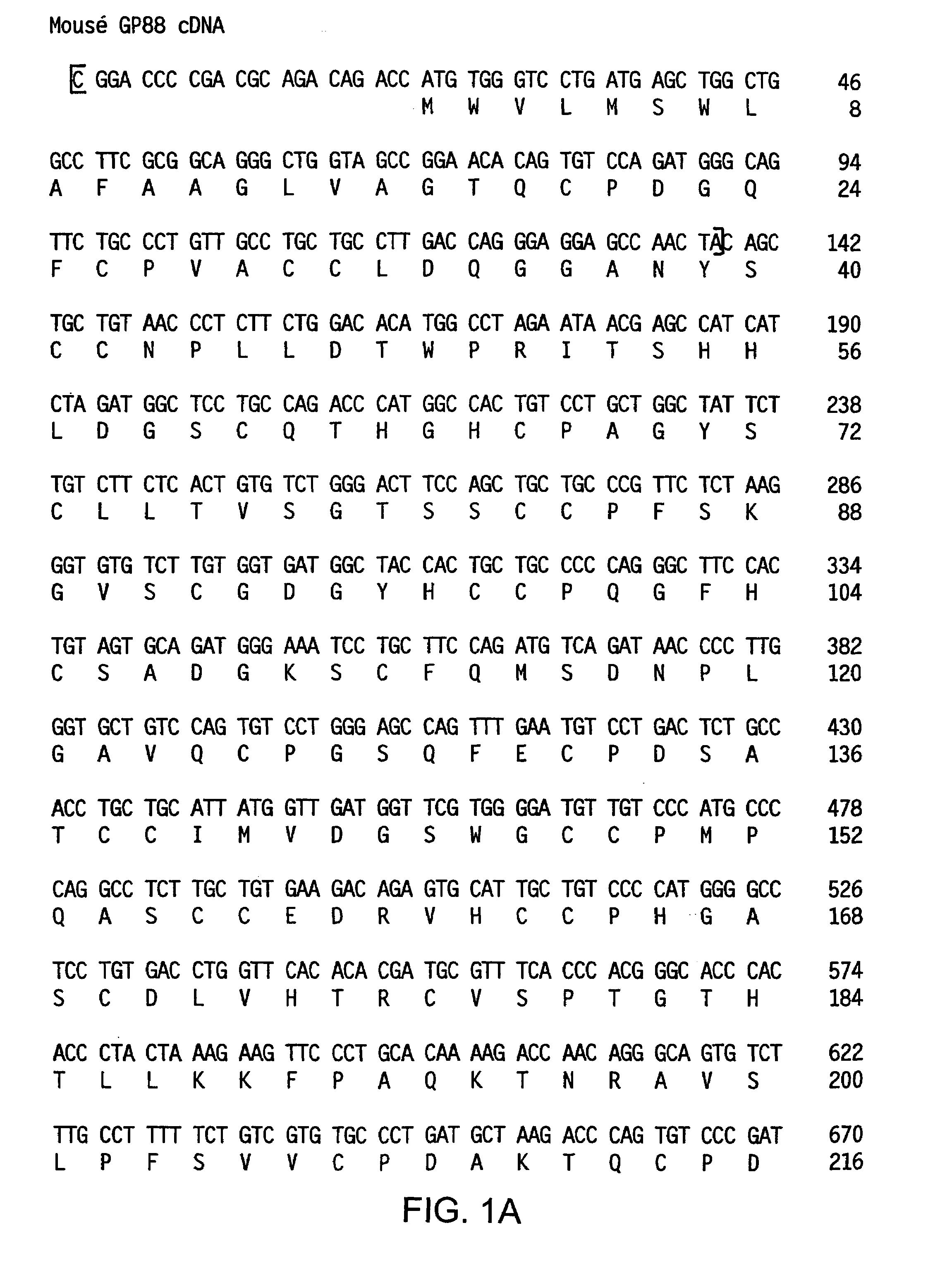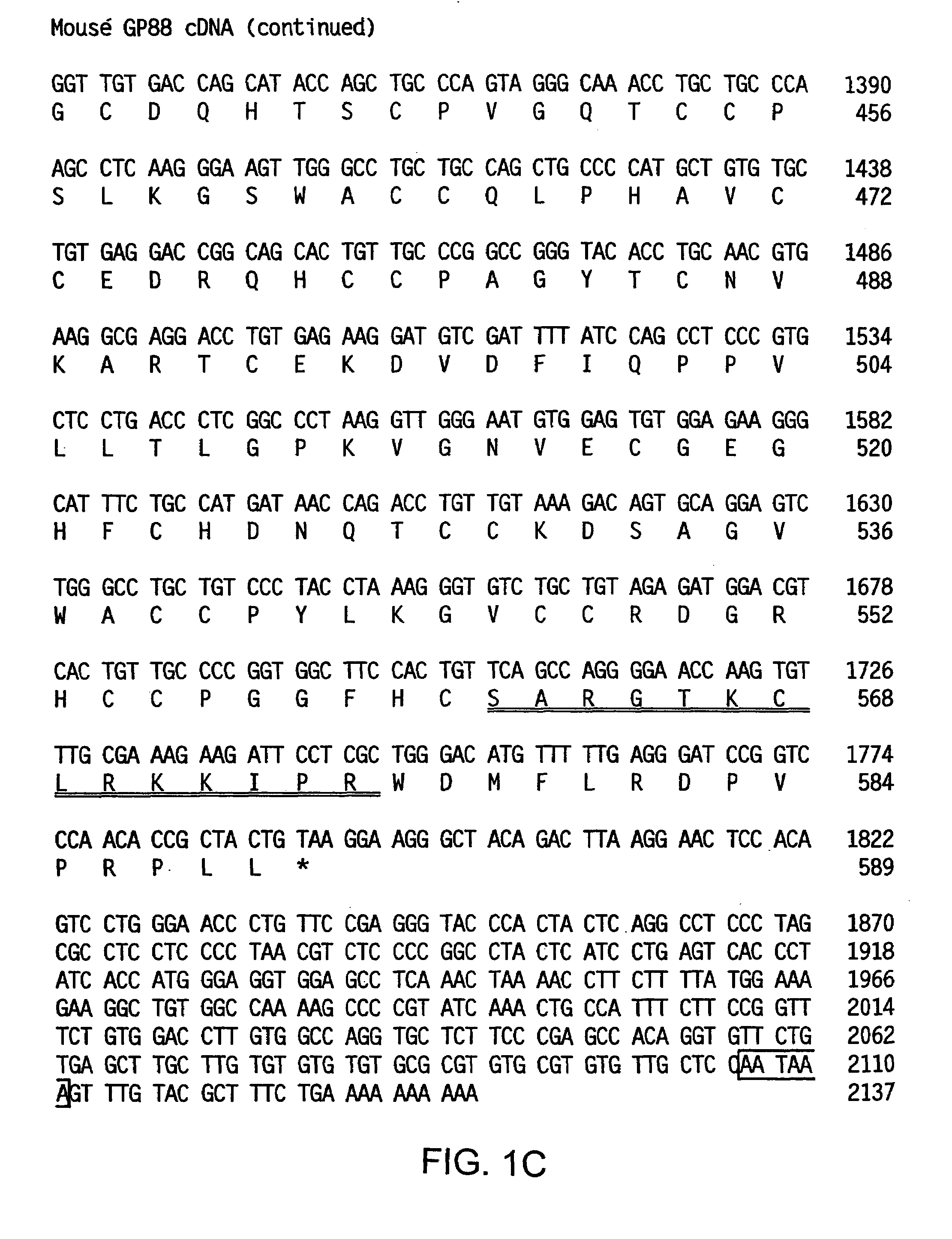Compositions and methods for restoring sensitivity of tumor cells to antitumor therapy and inducing apoptosis
a tumor cell and antitumor technology, applied in the field of cell biology, physiology and medicine, can solve the problems of unregulated growth and uncontrolled growth, and achieve the effects of improving the solubility of proteins, and reducing the risk of cancer
- Summary
- Abstract
- Description
- Claims
- Application Information
AI Technical Summary
Benefits of technology
Problems solved by technology
Method used
Image
Examples
example 1
GP88 Antagonists Induce Apoptosis In Tamoxifen-Treated Cells
[0133]GP88 overexpression blocks down-regulation of Bcl-2 mRNA transcript in response to tamoxifen treatment. MCF-7 cells and MCF-7 cells overexpressing GP88 (O4 cells) were treated with 0 to 2 μm tamoxifen. FIG. 6. 5 μg of total RNA was reverse transcribed into single strand cDNA by Super Script II (BRL, Gaithersburg, Md.) using 20 ng random hexamer (Gibco) as primer. The reverse transcription reaction was carried out for 1 h at 42 C in 10 nM Tris-HCl (pH8.3), 2.5 mM MgCl2, 50 mM KCl, DTT 0.01 M and dNTP (each 0.5 mM). A total of 30-35 PCR cycles depending on the gene amplified were performed, followed by electrophoresis on 1% agarose gel. The specific primer pairs used were as follows: for glyceraldehyde 3-phosphate dehydrogenase (GAPDH): forward primer 5′ TGAAGGTCGGAGTCAACGGATTTGGT 3′ (SEQ ID NO: 9), reverse primer, 5′ CATGTGGGCCATGAGGTCCACCAC 3′ (SEQ ID NO: 10); for Bcl-2: forward primer 5′ GGTGCCACCTGTGGTCCACCTG 3′ (SE...
example 2
Anti-GP88 Antibody 5B4 Induces Apoptosis in Cells Overexpressing GP88 (O4 Cells) or Cells Resistant to Tamoxifen
[0135]As discussed above, cleavage of PARP releases an 85 kDa fragment indicating the cell is undergoing apoptosis. Western blot analysis using an anti-PARP antibody revealed the presence or absence of apoptosis in cells treated with combinations of tamoxifen, anti-GP88 antibody, and estradiol.
[0136]MCF-7 cells or O4 cells were seeded at a density of 7×105 cells in 60-mm dish in DMEM / F12 supplemented with 5% FBS. After 24 hours, medium was changed to serum-free phenol red-free DMEM / F12 supplemented with vehicle or purified GP88. After another 24 hours, cells were treated with either vehicle only or various combinations of tamoxifen, anti-GP88 antibody, estradiol, or vehicle for 24 hours. Cell lysates were collected in 6M urea in RIPA buffer (50 mM Tris HCl pH 7.4, 1% NP-40, 0.25% sodium deoxycholate, 150 mM NaCl, 1 mM EDTA, 1 mM sodium orthovanadate, 1 mM NaF, protease inh...
PUM
| Property | Measurement | Unit |
|---|---|---|
| tumor volume | aaaaa | aaaaa |
| volume | aaaaa | aaaaa |
| concentrations | aaaaa | aaaaa |
Abstract
Description
Claims
Application Information
 Login to View More
Login to View More - R&D
- Intellectual Property
- Life Sciences
- Materials
- Tech Scout
- Unparalleled Data Quality
- Higher Quality Content
- 60% Fewer Hallucinations
Browse by: Latest US Patents, China's latest patents, Technical Efficacy Thesaurus, Application Domain, Technology Topic, Popular Technical Reports.
© 2025 PatSnap. All rights reserved.Legal|Privacy policy|Modern Slavery Act Transparency Statement|Sitemap|About US| Contact US: help@patsnap.com



